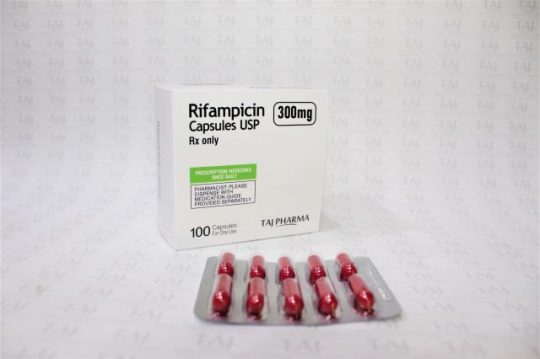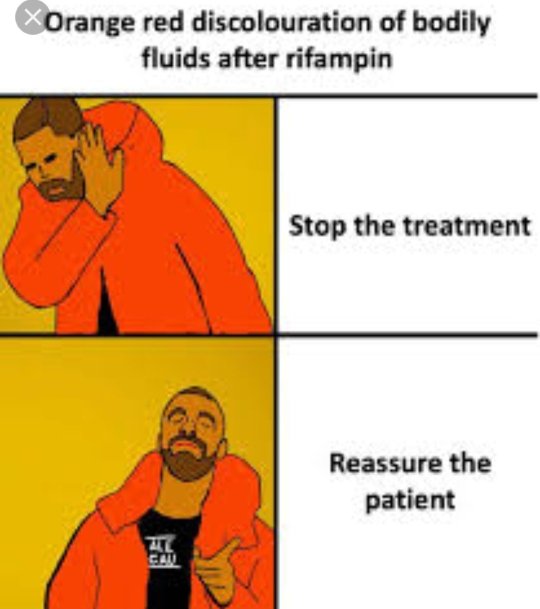#rifampicin
Explore tagged Tumblr posts
Text

Rifampicin (ไรแฟมพิซิน)
Rifampicin (ไรแฟมพิซิน)
Rifampicin (ไรแฟมพิซิน) คือ ยาปฏิชีวนะที่ทางการแพทย์ใช้ป้องกันหรือรักษาวัณโรค รักษาการติดเชื้อในจมูกและลำคอจากแบคทีเรียบางชนิดที่เป็นสาเหตุของโรคเยื่อหุ้มสมองอักเสบ โรคไข้กาฬหลังแอ่นชนิดเยื่อหุ้มสมองอักเสบ หรือโรคติดเชื้อชนิดอื่น รวมทั้งช่วยป้องกันการแพร่เชื้อดังกล่าวไปสู่ผู้อื่น แต่จะไม่นำมาใช้รักษาโรคเยื่อหุ้มสมองอักเสบในระยะที่แสดงอาการแล้ว

เกี่ยวกับ Rifampicinกลุ่ม��ายาปฏิชีวนะประเภทยายาตามใบสั่งแพทย์ สรรพคุณป้องกันหรือรักษาวัณโรค รักษาโรคเยื่อหุ้มสมองอักเสบในระยะยังไม่แสดงอาการกลุ่มผู้ป่วยเด็กและผู้ใหญ่รูปแบบของยายารับประทาน ยาฉีดเข้าเส้นเลือด

คำเตือนการใช้ยา Rifampicin
หากเคยมีประวัติแพ้ไรแฟมพิซิน ยา อาหาร หรือสารชนิดอื่น ๆ ควรแจ้งให้แพทย์ทราบก่อนใช้ยา
ไม่ควรใช้ยาชนิดนี้ หากกำลังใช้ยาต้านเชื้อเอชไอวี เช่น ซาควินาเวียร์ ริโทนาเวียร์ เป็นต้น เนื่องจากยาไรแฟมพิซินอาจทำให้ประสิทธิภาพของยาต้านเชื้อเอชไอวีลดลง
ห้ามฉีดวัคซีนทุกชนิดขณะใช้ยาไรแฟมพิซิน เพราะอาจทำให้ประสิทธิภาพของวัคซีนลดลง ยกเว้นกรณีที่แพทย์แนะนำ
แจ้งประวัติการเจ็บป่วยให้แพทย์ทราบ โดยเฉพาะผู้ป่วยโรคเบาหวาน โรคตับ โรคติดเชื้อเอชไอวี หรือผู้ที่มีประวัติติดแอลกอฮอล์ เพราะยาไรแฟมพิซินอาจส่งผลให้อาการของโรคนั้น ๆ รุนแรงขึ้น หรืออาจทำปฏิกิริยากับยาชนิดอื่นที่กำลังรับประทานอยู่
หากกำลังใช้ยา สมุนไพร หรือผลิตภัณฑ์เสริมอาหารชนิดใดก็ตาม ควรแจ้งให้แพทย์ทราบก่อนใช้ยาชนิดนี้
หลีกเลี่ยงการดื่มแอลกอฮอล์ขณะใช้ยา
ห้ามใส่คอนแทคเลนส์ขณะใช้ยา เนื่องจากยาไรแฟมพิซินอาจทำให้สีของน้ำตาเปลี่ยนไป ส่งผลให้เกิดคราบติดบนคอนแทคเลนส์อย่างถาวรได้
ผู้ที่กำลังใช้ยาไรแฟมพิซินต้องแจ้งให้แพทย์ทราบก่อนวางแผนผ่าตัดหรือรับการรักษาทางทันต���รรม
ห้ามขับรถ ใช้เครื่องจักร หรือทำกิจกรรมที่มีความเสี่ยงสูงขณะใช้ยา เพราะยาชนิดนี้อาจมีผลข้างเคียงทำให้รู้สึกวิงเวียนศีรษะหรือง่วงซึม
ยาไรแฟมพิซินอาจส่งผลให้ยาคุมกำเนิดมีประสิทธิภาพลดลง ขณะใช้ยานี้จึงควรใช้วิธีคุมกำเนิดด้วยรูปแบบอื่นที่ไม่ใช้ฮอร์โมนแทน เช่น ถุงยางอนามัย ห่วงคุมกำเนิด เป็นต้น
หญิงตั้งครรภ์และหญิงที่กำลังให้นมบุตรควรแจ้งให้แพทย์ทราบก่อนใช้ยาและควรใช้ยาเมื่อจำเป็นเท่านั้น เพราะการใช้ยาไรแฟมพิซินในช่วงก่อนคลอด 2-3 สัปดาห์ อาจทำให้มารดาหรือทารกเสี่ยงมีภาวะเลือดออกได้
ปริมาณการใช้ยา Rifampicin


รักษาวัณโรค
ผู้ใหญ่
ยารับประทาน
ผู้ที่มีน้ำหนักน้อยกว่า 50 กิโลกรัม รับประทานวันละ 1 ครั้ง ครั้งละ 450 มิลลิกรัม
ผู้ที่มีน้ำหนัก 50 กิโลกรัมขึ้นไป รับประทานวันละ 1 ครั้ง ครั้งละ 600 มิลลิกรัม
ยาฉีดเข้าเส้นเลือด
ฉีดยาวันละ 1 ครั้ง ครั้งละ 10 มิลลิกรัมต่อน้ำหนักตัว 1 กิโลกรัม ปริมาณสูงสุดไม่เกิน 600 มิลลิกรัมต่อวัน
เด็ก
ยารับประทาน
รับประทานวันละ 1 ครั้ง ครั้งละ 10-20 มิลลิกรัมต่อน้ำหนักตัว 1 กิโลกรัม ปริมาณสูงสุดไม่เกิน 600 มิลลิกรัมต่อวัน
ยาฉีดเข้าเส้นเลือด
ฉีดยาวันละ 1 ครั้ง ครั้งละ 10 มิลลิกรัมต่อน้ำหนักตัว 1 กิโลกรัม ปริมาณสูงสุดไม่เกิน 600 มิลลิกรัมต่อวัน

ป้องกันโรคไข้กาฬหลังแอ่นในกรณีเป็นพาหะแพร่เชื้อ
ผู้ใหญ่
ยารับประทาน
รับประทานครั้งละ 600 มิลลิกรัม วันละ 2 ครั้ง ติดต่อกัน 2 วัน
ยาฉีดเข้าเส้นเลือด
ฉีดยาครั้งละ 600 มิลลิกรัม วันละ 2 ครั้ง ติดต่อกัน 2 วัน
เด็ก
ยารับประทาน
ทารกอายุน้อยกว่า 1 เดือน รับประทานครั้งละ 5 มิลลิกรัมต่อน้ำหนักตัว 1 กิโลกรัม ทุก ๆ 12 ชั่วโมง ติดต่อกัน 2 วัน
ทารกอายุตั้งแต่ 1 เดือนขึ้นไป รับประทานยาครั้งละ 10 มิลลิกรัมต่อน้ำหนักตัว 1 กิโลกรัม ทุก ๆ 12 ชั่วโมง ติดต่อกัน 2 วัน ปริมาณสูงสุดไม่เกิน 600 มิลลิกรัมต่อครั้ง
ยาฉีดเข้าเส้นเลือด
ทารกอายุน้อยกว่า 1 เดือน ฉีดยาครั้งละ 5 มิลลิกรัมต่อน้ำหนักตัว 1 กิโลกรัม ทุก ๆ 12 ชั่วโมง ติดต่อกัน 2 วัน
ทารกอายุตั้งแต่ 1 เดือนขึ้นไป ฉีดยาครั้งละ 10 มิลลิกรัมต่อน้ำหนักตัว 1 กิโลกรัม ทุก ๆ 12 ชั่วโมง ติดต่อกัน 2 วัน ปริมาณสูงสุดไม่เกิน 600 มิลลิกรัมต่อครั้ง

การใช้ยา Rifampicin
ใช้ยาตามคำแนะนำของแพทย์ ไม่ควรใช้ในปริมาณมากกว่า น้อยกว่า หรือใช้ติดต่อกันนานกว่าที่กำหนด
ควรรับประทานยาไรแฟมพิซินขณะท้องว่าง ก่อนรับประทานอาหาร 1 ชั่วโมง หรือหลังรับประทานอาหาร 2 ชั่วโมง
ไม่ควรรับประทานยาลดกรดใน 1 ชั่วโมงแรกหลังจากใช้ยาไรแฟมพิซินชนิดแคปซูล เพราะอาจทำให้ประสิทธิภาพของยาไรแฟมพิซินลดลง
ควรรับประทานยาติดต่อกันให้ครบตามที่แพทย์แนะนำและรับประทานให้ตรงเวลา เพราะการใช้ยาไม่สม่ำเสมอหรือหยุดใช้ยาก่อนครบกำหนด อาจทำให้เสี่ยงต่อการดื้อยาและส่งผลกระทบต่อการทำงานของไตได้
หากลืมรับประทานตามเวลาที่กำหนดให้รับประทานทันทีที่นึกได้ หากใกล้ถึงเวลาแล้ว ให้ข้ามไปรับประทานครั้งต่อไปได้เลย โดยไม่ต้องเพิ่มปริมาณเป็น 2 เท่า
เก็บยาไว้ที่อุณหภูมิห้อง ป้องกันไม่ให้ถูกแสงแดด และใส่ในภาชนะที่ปิดฝาสนิททุกครั้งหลังใช้
ผลข้างเคียงจากการใช้ยา Rifampicin
ผลข้างเคียงจากการใช้ยาไรแฟมพิซินที่พบได้บ่อย คือ แสบร้อนกลางอก เกิดแก๊สในกระเพาะอาหาร ท้องเสีย เบื่ออาหาร คลื่นไส้ อาเจียน ปวดท้อง ปวดศีรษะ มึนงง อ่อนเพลีย กล้ามเนื้ออ่อนแรง เจ็บตามแขนหรือขา มองเห็นผิดปกติ ผิวแดง พฤติกรรมเปลี่ยนไป หรือไม่มีสมาธิ รวมทั้งอาจทำให้สารคัดหลั่งของร่างกายเปลี่ยนเป็นสีแดงอมน้ำตาล เช่น เหงื่อ ปัสสาวะ น้ำลาย น้ำตา เป็นต้น ทั้งนี้ ยาไรแฟมพิซินอาจส่งผลข้างเคียงรุนแรง ผู้ป่วยควรไปพบแพทย์ทันทีหากมีอาการต่อไปนี้
มีอาการแพ้ เช่น หายใจลำบาก เป็นลมพิษ ใบหน้า คอ ริมฝีปาก หรือลิ้นบวม
มีเลือดออก เช่น เลือดกำเดาไหล เลือดออกตามไรฟัน
มีอาการคล้ายไข้หวัดใหญ่ เช่น มีไข้ หนาวสั่น ปวดตามร่างกาย ปวดศรีษะ รู้สึกมึนงง เป็นต้น
ท้องเสียรุนแรง ถ่ายเป็นน้ำหรือถ่ายเหลวมีเลือดปน
ตับทำงานผิดปกติ ส่งผลให้ปวดท้องส่วนบน รู้สึกเหนื่อย เบื่ออาหาร ปัสสาวะมีสีเข้ม มีภาวะดีซ่าน
เกิดความผิดปกติทางผิวหนังอย่างรุนแรง เช่น บวมตามใบหน้า ลำคอ ลิ้น หรือริมฝีปาก รู้สึกแสบร้อนบริเวณตา เจ็บปวดตามผิวหนัง ตามมาด้วยผื่นแดงตามร่างกาย โดยเฉพาะบริเวณใบหน้าหรือลำตัวช่วงบน และผิวลอก
รายการยาและการสนับสนุนยารักษาวัณโรค วัณโรคดื้อยาและวัณโรคระยะแฝง
CR :: https://www.pobpad.com/rifampicin

6 notes
·
View notes
Text
India Set to Roll out Key Tuberculosis Drug Rifampicin in 2025 @neosciencehub #Tuberculosis #Rifampicin #India #Covid19 #neosciencehub
0 notes
Text

TSRNOSS, p371.
#MHC variability#nystatin#natamycin#yeast#fungi#commensals#superoxide#ototoxicity#plasmids#adenosine#vasodilation#rifampicin#muscle fatigue#satyendra sunkavally#theoretical biology#cursive handwriting#manuscript
0 notes
Note
Rifampicin (and the class of rifamycins as a whole) were named after a French noir film, Rififi (1955). Rifampicin itself stands for Rif-AMP-(m)icin, with AMP referring to its N-amino-N′-methylpiperazine substitution.
Who says we can't have the pharmaceutical equivalent the sonic the hedgehog protein.
That’s hilarious and when I design this med I will absolutely base it on said movie as well. Bros gonna have a fedora or something.
Also Rifa over here is another member of the “biblically accurate angel looking skeletal structure” club along with Vitamin B12


0 notes
Text
Acid-Fast Bacillus (AFB) Test: Types, Procedure, Results & TB
Learn everything about Acid-Fast Bacillus (AFB) tests including AFB smear, culture, NAAT, and drug susceptibility testing. Understand how these tests help diagnose tuberculosis (TB) and other mycobacterial infections. Acid-Fast Bacillus (AFB) Tests: Complete Medical Guide Acid-Fast Bacillus (AFB) Test: Types, Procedure, Results & TB Diagnosis Overview: What Are AFB Tests? Acid-Fast Bacillus…
#acid fast test#acid-fast bacillus test#AFB culture#AFB smear#AFB test#AFB test procedure#drug-resistant TB test#mycobacterial infection test#NAAT test TB#rifampicin resistance test#sputum test for TB#TB culture and sensitivity#TB NAAT test#TB test#tuberculosis diagnosis
0 notes
Text
Woke up at 3 AM from a nightmare about a smug, depressing "dark comedy"/horror anime about a town with a "haunted house" where kids dare themselves to spend the night. Sometimes this ritual "triggers the latent powers" of those with the potential to become "ghost hunters," those chosen to protect the world from ghosts.
From these kids' point of view, it's a normal shounen series - but about half of each episode is from the PoV of a "normal kid" they don't respect. One of these girls slowly works out that the dirty water in and around the house is giving the others a brain infection, which typically kills them within 2-8 years, because they never get appropriate medical treatment in time. (I think this involved rifampicin.)
This has been going on in this town for at least 20 years due to defunding of public health and education: very few of the kids have had any vaccinations, the local churches don't believe in microscopic organisms, "science classes" at the kids' schools are just YouTube playlists of videos which have been approved by said churches, etc. Real estate market manipulation by landlords renders it basically impossible to condemn unsafe structures like the "haunted house."
When I woke up I had a nose bleed and felt really overheated and dehydrated, so I think I have Madoka-Legionnaire's.
104 notes
·
View notes
Text
Cytochrome P450 Inducers & Inhibitors
The main ones can be remembered using "CRAP GPs spend all day on SICKFACES.COM".
Cytochrome P450 Inducers
These induce CYP450 activity, and thus reduce the concentration of drugs which are metabolised by this system.
Carbemazepine Rifampicin Alcohol (chronic use) Phenytoin Griseofulvin Phenobarbitone Sulphonylureas, St John's Wort, Smoking
Also topiramate.
Cytochrome P450 Inhibitors
These inhibit CYP450 enzyme activity and thus increase the concentration of drugs which are metabolised by this system.
Sodium valproate Isoniazid Cimetidine Ketoconazole Fluconazole Alcohol (acute use), Amiodarone, Allopurinol Chloramphenicol Erythromycin Sulfonamides, SSRIs Ciprofloxacin Omeprazole Metronidazole
Also grapefruit, cranberry juice, diltiazem, verapamil, clarithromycin.
Common Interactions
Medications which commonly interact with CYP450 inhibitors and inducers are:
Warfarin
Phenytoin
Combined Oral Contraceptive Pill (COCP)
Theophylline
Corticosteroids
Tricyclic antidepressants
Statins
Lamotrigine
Midazolam
#medical school#pharmacology#drug interactions#mnemonic#prescribing#med student#revision#cytochrome p450#cyp450#medicine#studyblr#medblr#warfarin
12 notes
·
View notes
Note
I see your Ochem hate/love discussion and raise you pharmaceutical (medicinal) chemistry. It's like Ochem but worse. Now you not only have synthesis reactions and mechanisms and NMR but you have the added bonus of having to remember a fuck ton of drug structures, many of who do not have the business of being that fucking large. Itraconazol, Amphotericin B, Rifampicin and Glecaprevir, I hate you. And not only that, you need to know where you could change what part of the structure of said drug to make it last longer or work better or whatever. Why do so many drug names sound the same. Maybe I had would have an easier time remembering antiviral drugs if they didn't all fucking sound the same.
(Also you are totally right in hating Ochem)
Love, a pharmacy student
Okay so I looked them up and holy fuck




What the hell are these. They're so huge tumblr can't even show them whole, you have to click on the pictures to see them. What.
Also, my faculty offers a degree in medicinal chemistry and we have a couple of students in my year who transferred from there to our degree ("just" chemistry) and they all agree medicinal chemistry is straight-up traumatizing. I have insane respect for you pharma (and adjacent) people, the amount of knowledge you have to integrate to do such an important job is just 😳
14 notes
·
View notes
Text
i found these out at 4 in the morning when i acidentally bumped into a subcommunity of people fully dedicated to making memes of how rifampicin (drug used 2 treat tuberculosis and leprosy) turns bodily fluid (and organs) neon-orange





10 notes
·
View notes
Text
I'm seeing a lot of "I can't believe we have this in 2025" posts, so wanted to add this info, which I originally gathered for something on my side blog:
According to the World Health Organization, tuberculosis (TB) is currently one of the top 10 global causes of death. It is the leading global cause of death from infectious disease.
There are more people dying annually from tuberculosis now than there were during the Victorian era.
It's also been on the rise in the US in recent years, with the largest recent outbreak in 2015-2017, and more than 9,000 cases recorded in 2023, the largest number in over a decade.
TB is caused by bacteria. Specifically, by Myobacterium tuberculosis (M. tuberculosis), which spreads through the air when people who are actively sick with TB cough.
According to the CDC, you can only become infected by breathing M. tuberculosis coughed up by a sick person. You can not become infected by sharing food or drinks, using the same bathroom, sharing bed linens or clothing, touching shared surfaces, shaking hands, or even kissing.
Importantly, being infected by the bacteria does not mean you will develop tuberculosis if you have a normally functioning immune system.
TB infection can either be latent or active. Active means you are sick with tuberculosis and can spread it to other people. Latent means the bacteria is in your body, but you are not sick with TB and cannot spread TB to others.
The World Health Organization estimates in its 2020 report that approximately a quarter of the world’s population – that is, one in every four people – carries the bacteria.
If you are one of them, the disease can become active in the future (something that happens only to 5-10% of infected people).
It usually becomes active if something significantly lowers your immune system, for example a serious illness, cancer treatment, or using certain medications. This is why many medicines say you must get checked for TB before beginning treatment.
Today, tuberculosis is treatable using modern medicine. “Modern” is a relative term because the most recent first-line treatment drug, rifampicin, was developed in 1967, and the most common treatment regimen dates to the 1980s.
However, in many parts of the world, people either cannot afford or do not have access to these medications and when TB is untreated, it only has two possible outcomes: self-cure or death. As many as 70% of individuals with active TB die within 5 years of diagnosis, more than half of them within the first two years, while the remaining 30% spontaneously recover.
Point being, TB has continuously been around through the 20th and 21st Centuries. You don't hear about it as much because it's not common in some countries, like the United States or Canada.
If your immune system works, you don't really have a ton to worry about, even if you're in close contact with infected individuals. It's very treatable if you do get it. So don't freak out about it too much.
There's a vaccine, by the way. If you're in frequent contact with infected people, it's recommended, but it's not super effective anyway.

"In case anyone missed it, the tuberculosis outbreak in Kansas has now spread to Ohio.
[The Republican Administration] has ordered the CDC to not report on this"
37K notes
·
View notes
Text

Flufab N: A Complete Multi-Symptom Relief Tablet
Overview of Ingredients
(Caffeine 30mg + Cetirizine 5mg + Nimesulide 100mg + Paracetamol 325mg + Phenylephrine 5mg)
Flufab N is a scientifically crafted combination medicine that offers effective relief from multiple symptoms commonly associated with flu, cold, seasonal allergies, and viral fever. It contains:
Caffeine 30mg – Acts as a mild stimulant and enhances the effectiveness of painkillers like Paracetamol.
Cetirizine 5mg – An antihistamine that controls allergic reactions such as sneezing, watery eyes, and runny nose.
Nimesulide 100mg – A non-steroidal anti-inflammatory drug (NSAID) that reduces inflammation, pain, and fever.
Paracetamol 325mg – A trusted antipyretic and analgesic that helps lower fever and manage body pain.
Phenylephrine 5mg – A nasal decongestant that helps open up blocked nasal passages and reduces sinus pressure.
Together, these ingredients target both the cause and symptoms, providing comprehensive relief.
Benefits of the Multi-Action Formula
Why Choose Flufab N for Symptom Relief
Flufab N is designed to offer maximum relief using a single tablet. Here’s how this combination works effectively across multiple symptoms:
Fever and Pain Management
The combination of Paracetamol and Nimesulide helps in quickly reducing fever.
It effectively relieves body pain, muscle aches, and headaches that commonly occur with viral infections or seasonal flu.
Nasal Congestion Relief
Phenylephrine works by shrinking swollen blood vessels in the nasal passages.
It clears nasal blockage, allowing for easier breathing and reducing sinus pressure.
Control of Allergic Reactions
Cetirizine blocks histamines in the body, which are responsible for allergic symptoms like sneezing, itchy throat, and watery eyes.
It provides long-lasting relief from these symptoms with minimal drowsiness.
Improved Energy and Alertness
Caffeine helps counteract fatigue and the sedative effects of Cetirizine.
It keeps you alert and helps you go through your day with improved energy, especially during illness.
All-in-One Convenience
Reduces the need to take 3–4 different medications.
Lowers the risk of taking the wrong combination or missing a dose.
This makes Flufab N a smart and reliable choice for managing multiple symptoms with one tablet.
When and How to Take Flufab N
Dosage and Food Considerations
Flufab N should ideally be taken after food to reduce the risk of stomach upset, especially due to Nimesulide.
The typical dosage is one tablet twice daily or as advised by your healthcare provider.
Since the tablet contains caffeine, it is better to avoid taking it late in the evening to prevent sleep disturbance.
Ensure at least a 4 to 6-hour gap between doses if you are taking any other medication alongside.
Always follow the prescribed dosage and consult your doctor if symptoms persist.
Drug Interactions to Be Aware Of
Use with Caution in Certain Cases
Flufab N’s ingredients may interact with other medications. Always inform your doctor about all medicines you are taking. Be cautious if:
You Are Taking Other Pain Relievers
Avoid combining with other Paracetamol or NSAID-based drugs to prevent the risk of liver and kidney damage.
You Are on Sedatives or Alcohol
Cetirizine may enhance the sedative effects when taken with alcohol or sleeping pills, leading to excessive drowsiness.
You Have High Blood Pressure
Phenylephrine may interfere with medications used to manage blood pressure and can increase heart rate or cause palpitations.
You Consume High-Caffeine Products
Excessive caffeine intake from coffee, tea, or energy drinks can lead to restlessness, insomnia, and increased heart rate.
You Are Using Liver-Affecting Antibiotics
Some antibiotics like rifampicin can interfere with Paracetamol metabolism and increase the risk of liver toxicity.
Always consult a healthcare professional before starting Flufab N if you have any ongoing medication or health condition.
Conclusion
Fast, Safe, and Effective Multi-Symptom Relief
Flufab N is a powerful and convenient solution for managing cold, flu, and allergy-related symptoms. Its five active ingredients work together to reduce fever, pain, nasal congestion, and allergic reactions while keeping you alert and comfortable.
It offers a complete treatment in one tablet, reducing the hassle of juggling multiple medications. For best results, take it as prescribed, follow the timing guidelines, and be aware of possible drug interactions.
Flufab N is your trusted ally for quick recovery and symptom control.
0 notes
Text
Surgical Options for Drug-Resistant and MDR-TB Patients

Drug-resistant TB, that is, multidrug-resistant (MDR) and large-scale drug-resistant (XDR) surgical procedures for TB, are required for the treatment of the patient in cases where medical treatment will not be sufficient.
For drug-resistant TB patients of Thane who require complex treatment, such hospitals as a lung surgery hospital in Thane offer special surgical procedures, specialist in-house specialists, and intensive postoperative facilities.
This piece of writing discusses the symptoms, classification, and results of surgery in drug-resistant TB and claims that specialist treatment is essential to attain maximum results.
The Challenge of Drug-Resistant TB
DR-TB, and especially MDR and XDR-TB, is a major public health problem. MDR-TB is resistant to rifampicin and isoniazid, the most effective first-line drugs against TB. XDR-TB is resistant to them, as well as to one of the other classes of drugs, including fluoroquinolone and injection. DR-TB treatment is multifaceted, long, and usually accompanied by severe side effects and lower cure rates than drug-susceptible TB.
When drug treatment is unable to suppress the disease—most importantly, in localised, cavitary, or fibrotic pulmonary lesions—surgery is a value-added component of chemotherapy. The objectives of surgery are to excise infected lung tissue, decrease the bacterial load, and raise the cure rate.
Indications for Surgery in Drug-Resistant TB
Surgery should be done in patients who:
Are sputum-positive despite proper drug therapy
Has been exposed to such complications as hemoptysis, bronchiectasis, or secondary infection
Has limited pulmonary disease, and resection will be safe and feasible
Types of Surgical Procedures
Many different types of surgical procedures can be carried out in the case of drug-resistant TB, depending on the location and size of the disease:
Lobectomy: Removal of the entire lobe of the lung. It is the most common operation for focal disease.
Segmentectomy or Wedge Resection: Wedge or segmental resection of the small lung for the small lesion.
Pneumonectomy: Extraction of the entire lung, reserved for extensive or central disease.
Combined Resection: Extraction of two or more segments or lobes, sometimes required for complex disease.
Collapse Therapy (Thoracoplasty, Artificial Pneumothorax): Used in extensive disease or when resection is not feasible. The above treatments collapse the affected lung to reduce cavitary disease and bacterial burden.
Preoperative and Postoperative Management
Effective preoperative and postoperative management should be given for successful surgical outcomes:
Preoperative Chemotherapy: Proper anti-TB chemotherapy for two months should be given to the patient before surgery to reduce the bacterial load and stabilise the disease.
Postoperative Chemotherapy: Anti-TB treatment for 12–24 months after surgery should be continued to avoid relapse and to eliminate infection.
Multidisciplinary Care: There should be collaboration among pulmonologists, infectious disease physicians, and surgeons to monitor, treat complications, and optimise recovery.
Outcome and Complications
Surgical resection, when combined with effective chemotherapy, has 90–95% cure rates for limited disease and 65–75% cure rates for advanced disease. Surgery is not without risks either:
Infection and wound complications
Prolonged air leaks
Respiratory failure
Bronchopleural fistula
The risk of procedure complications is greater in patients having disseminated disease, pre-existing pulmonary dysfunction, or disseminated drug resistance. The procedure will, therefore, need to be conducted by experienced thoracic surgeons in referral centres with ancillary facilities available.
Role of a Hospital for Lung Surgery in Thane
A lung surgery hospital in Thane has the infrastructure and expertise to carry out drug-resistant TB procedures safely and successfully. Such hospitals possess:
Modern diagnostic imaging and laboratory facilities
Highly qualified thoracic surgery personnel
Respiratory and critical care
Patient individualised care planning, multidisciplinary
Multidisciplinary rehabilitation and post-discharge follow-up
Advanced infrastructure, minimally invasive thoracic surgery, and patient-individualised treatment procedures are employed for the treatment of the patients.
Conclusion
One of the top thoracic surgeons at Thane, Dr. Amol Bhanushali, can perform complex lung surgeries and provide empathetic patient care. For all those who are going through illnesses inflicted by drug-resistant TB, a visit to a lung surgery hospital in Thane and treatment from Dr. Amol Bhanushali can change the lives and health of the patients entirely.
1 note
·
View note
Text
This is only true of a few rarely used antibiotics like rifampicin and rifabutin- the majority will not interfere with BC. Of course, absolutely use condoms if it will make you feel safer, but you don't need to.
(sources: 1, 2, 3)
Remember kids! NEVER save left-over antibiotics! You should never have leftover antibiotics, because you have to finish the whole course! Not doing so, or giving your antibiotics to someone else who hasn’t been prescribed them is how we got superbugs, that are resistant to antibiotics!
ALWAYS finish your antibiotics, even if you don’t think you’re sick anymore! NEVER give your antibiotics to other people, there is no guaruntee they will have any effect, or the same effect, and without a full course, will not help them even if it is the right medicine for the job.
BOTH cases result in resistant superbugs, which are dangerous to everyone, and hurt everyone. You might think you’re helping your poorer friends who cannot afford an antibiotic/to be seen by a doctor, but you’re not. You’re just hurting everyone.
49K notes
·
View notes
Text

Nursing Question-566. Microbiology MCQ Question.
Question is:
Drug of choice to treat leprosy is……
(a) Rifampicin
(b) Acyclovir
(c) Zidovudine
(d) Dapsone
Read more Microbiology MCQ- https://examobjective.com/microbiology-mcq-set-19/
0 notes
Text
Efficient Diagnosis of Hepatitis C and MDR Tuberculosis with PCR Technology

Accurate and early detection is the foundation of effective infectious disease management. In conditions like Hepatitis C and Tuberculosis, where treatment decisions rely on genetic information, real-time PCR technology has become a preferred diagnostic tool. The HCV kit and tuberculosis kit developed by 3B BlackBio Biotech offer dependable, rapid, and specific molecular detection methods suitable for both routine diagnostics and advanced clinical decision-making.
The global burden of Hepatitis C Virus (HCV) continues to affect public health systems due to the virus’s ability to cause chronic liver infections, cirrhosis, and liver cancer. Managing this condition depends largely on accurate genotyping. Different HCV genotypes respond differently to antiviral therapies, making genotype identification a prerequisite for initiating the correct treatment. The TRUPCR® HCV Genotyping Kit is built for precise genotype detection through real-time PCR. It identifies all six major HCV genotypes and subtypes with high analytical sensitivity and specificity.
Unlike traditional sequencing or hybridization-based approaches, this HCV kit offers faster turnaround times and streamlined protocols. Its multiplex PCR format enables simultaneous detection of multiple genotypes in one reaction, reducing resource usage and optimizing lab workflows. The assay runs on standard real-time PCR systems, making it suitable for both central and decentralized testing environments. With minimal hands-on time and reproducible results, the TRUPCR® HCV kit supports efficient clinical diagnostics for better patient outcomes.
On the other hand, Tuberculosis remains a leading cause of mortality worldwide, particularly with the increasing incidence of multidrug-resistant tuberculosis (MDR-TB). MDR-TB refers to tuberculosis strains resistant to both rifampicin and isoniazid, the two primary drugs used in first-line treatment.
Early identification of resistance mutations is essential to prevent ineffective treatments and further transmission. The TRUPCR® Drug Resistance MDR TB Kit is designed to detect Mycobacterium tuberculosis complex DNA and key genetic mutations associated with drug resistance.
This tuberculosis kit targets the rpoB gene for rifampicin resistance and katG/inhA mutations for isoniazid resistance. The use of real-time PCR allows for rapid detection directly from clinical samples, reducing the waiting time compared to culture-based methods. With integrated internal controls and validated primers, the assay ensures consistent accuracy across runs. Its compatibility with widely used PCR platforms adds flexibility for diagnostic labs dealing with high sample volumes or urgent clinical cases.
Both the HCV and tuberculosis kits are essential tools in molecular diagnostic labs. Their ability to deliver precise, mutation- or genotype-specific information in a short time enables informed treatment strategies and reduces reliance on slower, less specific methods. These kits are especially valuable in regions with high disease burden, where diagnostic efficiency can directly impact public health outcomes.
By focusing on molecular targets with clinical relevance, these PCR kits from 3B BlackBio Biotech enhance diagnostic reliability without increasing operational complexity. Their design incorporates practical features like internal controls, minimal reaction setup, and scalable throughput. This combination of accuracy, speed, and usability makes them well-suited for use in hospitals, reference labs, and national surveillance programs.
As treatment approaches evolve and resistance patterns become more complex, molecular diagnostics continue to play a central role in disease control. The HCV genotyping and MDR tuberculosis detection kits represent practical, validated solutions for modern diagnostic needs. Their integration into laboratory workflows supports faster decision-making, better therapy alignment, and ultimately, improved patient care.
With the increasing emphasis on personalized and precision medicine, tools like the TRUPCR® HCV and tuberculosis kits are no longer optional—they are essential. These PCR-based platforms are contributing to higher standards in infectious disease diagnostics by enabling targeted detection where it matters most.
0 notes
Text
Progressive Familial Intrahepatic Cholestasis Type 2 Treatment Market Size, Share, Trends, Key Drivers, Growth and Opportunity Analysis
"Global Progressive Familial Intrahepatic Cholestasis Type 2 Treatment Market - Size, Share, Demand, Industry Trends and Opportunities
Global Progressive Familial Intrahepatic Cholestasis Type 2 Treatment Market, By Drug (Ursodeoxycholic Acid, Cholestyramine, Rifampicin, Late Stage Pipeline Drugs, Others), Distribution Channel (Hospital Pharmacies, Retail Pharmacies, Online Pharmacies), Country (U.S., Canada, Mexico, Peru, Brazil, Argentina, Rest of South America, Germany, Italy, U.K., France, Spain, Netherlands, Belgium, Switzerland, Turkey, Russia, Hungary, Lithuania, Austria, Ireland, Norway, Poland, Rest of Europe, Japan, China, India, South Korea, Australia, Singapore, Malaysia, Thailand, Indonesia, Philippines, Vietnam, Rest of Asia Pacific, South Africa, Saudi Arabia, U.A.E, Kuwait, Israel, Egypt, Rest of Middle East and Africa) Industry Trends.
Access Full 350 Pages PDF Report @
**Segments**
- **Treatment Type**: The market for Progressive Familial Intrahepatic Cholestasis Type 2 (PFIC2) treatment can be segmented based on the type of treatment offered. This includes medications such as cholestyramine, ursodeoxycholic acid, rifampicin, and others. Surgical interventions like partial external biliary diversion, liver transplant, and gene therapy also fall under this category. Each of these treatment types plays a vital role in managing the symptoms and progression of PFIC2, contributing to the overall market growth.
- **Distribution Channel**: Another crucial segment in the PFIC2 treatment market is the distribution channel through which these treatments reach the patients. This can include hospitals, specialty clinics, retail pharmacies, and online pharmacies. The accessibility and availability of these distribution channels significantly impact the flow of treatment options to individuals diagnosed with PFIC2, thus influencing the market dynamics.
**Market Players**
- **Gilead Sciences, Inc.**: As one of the leading market players, Gilead Sciences, Inc. is actively involved in research and development activities for innovative PFIC2 treatment options. The company's strong focus on addressing unmet medical needs in liver diseases positions it as a key player in the market.
- **Mirum Pharmaceuticals, Inc.**: Mirum Pharmaceuticals, Inc. is another prominent player in the PFIC2 treatment market, with a portfolio of therapeutic candidates targeting liver diseases like PFIC2. The company's commitment to advancing novel treatment approaches underscores its importance in shaping the market landscape.
- **Albireo Pharma, Inc.**: Albireo Pharma, Inc. is known for its efforts in developing therapies for pediatric liver diseases, including PFIC2. The company's pipeline of promising treatment options showcases its dedication to improving patient outcomes in this niche segment of the market.
- **Novartis AG**: Novartis AG, a multinational pharmaceutical company, has also made significant strides in theNovartis AG is a key player in the Progressive Familial Intrahepatic Cholestasis Type 2 (PFIC2) treatment market, bringing a wealth of experience and resources to the table. The company's robust portfolio of pharmaceutical products includes treatments for various liver diseases, including PFIC2. Novartis AG's strong research and development capabilities enable them to innovate and create cutting-edge therapies that cater to the specific needs of patients suffering from PFIC2. Their global presence and established reputation in the pharmaceutical industry further solidify their position as a significant player in the market.
In terms of market strategy, Novartis AG focuses on leveraging its extensive network of healthcare professionals and key opinion leaders to drive awareness about PFIC2 and the available treatment options. By collaborating with medical institutions and advocacy groups, Novartis AG ensures that patients have access to timely and accurate information about the disease and its management. This proactive approach not only benefits individuals diagnosed with PFIC2 but also contributes to the overall growth of the treatment market by expanding the patient population seeking appropriate care.
Furthermore, Novartis AG's commitment to investing in research and development initiatives paves the way for continuous innovation in PFIC2 treatment modalities. The company actively engages in clinical trials and collaborations with academic institutions to explore novel therapeutic approaches that could revolutionize the management of PFIC2. By staying at the forefront of medical advancements and harnessing the power of cutting-edge technology, Novartis AG remains poised to shape the future of PFIC2 treatment and drive market expansion.
Moreover, Novartis AG's strong regulatory compliance and adherence to quality standards ensure that their PFIC2 treatment offerings meet strict efficacy and safety requirements. This instills confidence in healthcare professionals, patients, and regulatory authorities alike, reinforcing Novartis AG's position as a trusted and reliable partner in the PFIC2 treatment market. By prioritizing patient well-being and treatment effectiveness, the company sets a high bar for competitors and contributes to**Global Progressive Familial Intrahepatic Cholestasis Type 2 Treatment Market, By Drug**: - Ursodeoxycholic Acid - Cholestyramine - Rifampicin - Late Stage Pipeline Drugs - Others
**Global Progressive Familial Intrahepatic Cholestasis Type 2 Treatment Market, By Distribution Channel**: - Hospital Pharmacies - Retail Pharmacies - Online Pharmacies
**Market Analysis**: The Progressive Familial Intrahepatic Cholestasis Type 2 (PFIC2) treatment market is witnessing substantial growth due to the rising prevalence of liver diseases globally, including PFIC2. The segmentation based on treatment type allows for a more comprehensive approach in managing the condition, offering various options ranging from medications to surgical interventions. This diversified treatment landscape contributes to the market's expansion as it caters to the specific needs of individuals diagnosed with PFIC2. Additionally, the distribution channels play a vital role in ensuring the accessibility and availability of these treatments to patients, impacting the overall market dynamics.
Key market players such as Gilead Sciences, Inc., Mirum Pharmaceuticals, Inc., Albireo Pharma, Inc., and Novartis AG are actively involved in research and development efforts to advance innovative treatment options for PFIC2. These companies demonstrate a strong commitment to addressing unmet medical needs in liver diseases, especially in niche segments like PFIC2. Novartis AG, in particular, stands
Progressive Familial Intrahepatic Cholestasis Type 2 Treatment Key Benefits over Global Competitors:
The report provides a qualitative and quantitative analysis of the Progressive Familial Intrahepatic Cholestasis Type 2 Treatment Market trends, forecasts, and market size to determine new opportunities.
Porter’s Five Forces analysis highlights the potency of buyers and suppliers to enable stakeholders to make strategic business decisions and determine the level of competition in the industry.
Top impacting factors & major investment pockets are highlighted in the research.
The major countries in each region are analyzed and their revenue contribution is mentioned.
The market player positioning segment provides an understanding of the current position of the market players active in the Personal Care Ingredients
Table of Content:
Part 01: Executive Summary
Part 02: Scope of the Report
Part 03: Global Progressive Familial Intrahepatic Cholestasis Type 2 Treatment Market Landscape
Part 04: Global Progressive Familial Intrahepatic Cholestasis Type 2 Treatment Market Sizing
Part 05: Global Progressive Familial Intrahepatic Cholestasis Type 2 Treatment Market Segmentation By Product
Part 06: Five Forces Analysis
Part 07: Customer Landscape
Part 08: Geographic Landscape
Part 09: Decision Framework
Part 10: Drivers and Challenges
Part 11: Market Trends
Part 12: Vendor Landscape
Part 13: Vendor Analysis
Critical Insights Related to the Progressive Familial Intrahepatic Cholestasis Type 2 Treatment Included in the Report:
Exclusive graphics and Illustrative Porter’s Five Forces analysis of some of the leading companies in this market
Value chain analysis of prominent players in the market
Current trends influencing the dynamics of this market across various geographies
Recent mergers, acquisitions, collaborations, and partnerships
Revenue growth of this industry over the forecast period
Marketing strategy study and growth trends
Growth-driven factor analysis
Emerging recess segments and region-wise market
An empirical evaluation of the curve of this market
Ancient, Present, and Probable scope of the market from both prospect value and volume
The investment made in the study would provide you access to information such as:
Progressive Familial Intrahepatic Cholestasis Type 2 Treatment Market [Global – Broken-down into regions]
Regional level split [North America, Europe, Asia Pacific, South America, Middle East & Africa]
Country wise Market Size Split [of important countries with major market share]
Market Share and Revenue/Sales by leading players
Market Trends – Emerging Technologies/products/start-ups, PESTEL Analysis, SWOT Analysis, Porter’s Five Forces, etc.
Market Size)
Market Size by application/industry verticals
Market Projections/Forecast
Browse Trending Reports:
Wax and Wax Esters Market Cloud Storage Market Cleaning Service Software Market Non Hodgkin Lymphoma Market Propionic Acid Market Front and Rear Air-Conditioning (AC) Thermal Systems Market Sulfur Fertilizers Market Rail Public Transport Market Concrete Admixture Market Polyethylene Implants Market FinFET Technology Market Industrial Vehicles Market
About Data Bridge Market Research:
Data Bridge set forth itself as an unconventional and neoteric Market research and consulting firm with unparalleled level of resilience and integrated approaches. We are determined to unearth the best market opportunities and foster efficient information for your business to thrive in the market. Data Bridge endeavors to provide appropriate solutions to the complex business challenges and initiates an effortless decision-making process.
Contact Us:
Data Bridge Market Research
US: +1 614 591 3140
UK: +44 845 154 9652
APAC : +653 1251 975

Email: [email protected]"
0 notes